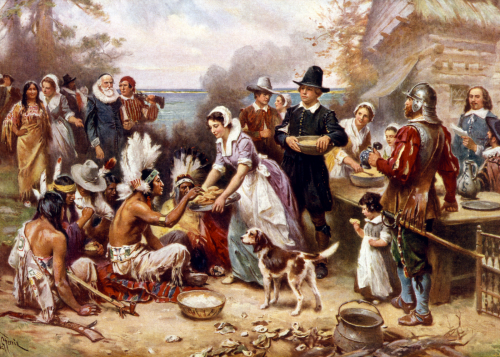WHAT THEY MEAN:
Exporters are the “cannon fodder” of trade wars — the unwitting front-line conscripts who lose sales, output, and jobs first when the targets retaliate. Cautiously unsealing statistics buried for a century in the 1936 edition of the Almanac of Statistical Extracts, here’s how they fared after the U.S. government’s last such venture, the “Tariff Act of 1930”:
| 1929 |
$5.24 billion |
| 1930 |
$3.85 billion |
| 1931 |
$2.42 billion |
| 1932 |
$1.61 billion |
With this experience grimly in mind, here are three perspectives on their modern descendants as of 2023:
1. Totals: The Census keeps the official records for these things, and reports that, adding it all together, Americans earned $3.07 trillion selling things to foreigners in 2023. This was 11% of U.S. GDP, down a notch from the 12% at the end of the Obama administration, and 3% of all world economic output. Using the standard-though-imperfect definitions of economic “sectors,” the single big Census number breaks down into slightly smaller ones as follows:
Manufacturers are the top exporters at $1.6 trillion. Samples include 3 million cars and trucks exiting Michigan, Alabama, South Carolina, etc., for parts abroad, along with $65 billion worth of auto parts for overseas factories and repair shops; $278 billion worth of chemicals, with Texas, Indiana, Puerto Rico, and California the largest sources; $130 billion in airplanes, drones, satellites and other aerospace; half a million microscopes and 656,000 MRI machines (California, Tennessee, Texas and Massachusetts lead for medical equipment), $107 billion worth of medicines.
Energy comes next at $324 billion, rising fast as liquefied natural gas from Texas and Louisiana replaces Russian energy in Europe.
Then come $250 billion in “business services” — an amorphous mix of things delivered mostly in digital form, ranging from architectural blueprints to software programs, legal documents, entertainment and media revenue, engineering services, and telemedicine diagnoses.
Agriculture contributes $174 billion: 17.8 million tons of wheat, 680,000 tons of almonds, and 3 million tons of pork; or in dollar terms, $4.3 billion worth of fresh fruit, $1.5 billion in wine, and $27 billion worth of soybeans. By way of context, this was nearly a third of last year’s $608 billion in gross farm income. Seafood adds another $5 billion, with Alaska, Washington, Florida, and Maine the top landing sites.
Travel services are close behind at $190 billion (visits for medical treatment, overseas student tuition, tourism in general); then add in $175 billion for financial services and $134 billion in intellectual property revenue, $98 billion in transport services, $50 billion for 17 million tons of metal ore and 3 million tons of scrap for $50 billion, and so on.
2. World Perspective: How does this look as against other large economies? Per the WTO’s World Trade Statistics 2023, the U.S.’ $3.07 trillion in total exports was the world’s second-largest total behind world behind China’s $3.76 trillion, with Germany third at $2.15 trillion, followed by the Netherlands, Japan, and France. Or, dividing things somewhat more finely, Americans are the largest exporters of farm products, energy, and services, and second to China for manufacturing.
3. At home: Taking these numbers from spreadsheets and GDP shares to daily life, the Census reports 278,000 American exporting businesses. Their joint deep dive into these firms, in partnership with the Bureau of Economic Analysis, identifies 161,000 by owner type — 21,626 women-owned firms, 1,139 African-American, 96 Native Hawaiian and Pacific Islander, 8,078 veteran-owned, 14,947 large publicly held and other “unclassifiable” companies — altogether employing 48 million people. The striking characteristic is their especially high pay: $80,536 in payroll per worker, nearly 50% above the $54,474 per worker for non-exporters. On the land, meanwhile, last year’s export share of farm income may be unusually high. But USDA notes that farmers and ranchers expect in any typical year to earn 20% of their income from overseas, nearly double the 11% average across the economy.
In sum: The export sector is quite large at $3 trillion. It pays workers well, is much more concentrated in goods production and high-end services than the U.S. economy as a whole, and is an especially important part of the American rural economy. Keep these things in mind in the year ahead.

FURTHER READING
Then:
From the Census archives, the Almanac of Statistical Abstracts for 1936 (see part 8 for the trade data).
And a look at the Tariff Act of 1930 (“Smoot-Hawley” for its authors, Senate Finance Committee Chairman Reed Smoot and House Ways and Means boss Willis Hawley).
And for the bigger picture, Kindleberger’s The World in Depression, 1929-1939.
Now:
Census trade data.
… counts of exporting and importing companies.
… and jointly with BEA, the deep dive on goods exporting companies, by size, market, race/ethnicity/gender of owners, and more.
U.S. Department of Agriculture briefs on ag trade.
The Energy Information Administration on the state of U.S. energy trade.
The Commerce Department’s International Trade Administration has state-by-state exports with products – from fish and semiconductors to tractors, fabric, medicine and sports equipment – and markets.
… and some more deep-dive work from the ITA statisticians finds 5.1 million of the U.S.’ 13.0 million manufacturing jobs “supported by exports”.
And international perspective:
The WTO’s World Trade Statistics 2023 places the U.S. in world context.
ABOUT ED
Ed Gresser is Vice President and Director for Trade and Global Markets at PPI.
Ed returns to PPI after working for the think tank from 2001-2011. He most recently served as the Assistant U.S. Trade Representative for Trade Policy and Economics at the Office of the United States Trade Representative (USTR). In this position, he led USTR’s economic research unit from 2015-2021, and chaired the 21-agency Trade Policy Staff Committee.
Ed began his career on Capitol Hill before serving USTR as Policy Advisor to USTR Charlene Barshefsky from 1998 to 2001. He then led PPI’s Trade and Global Markets Project from 2001 to 2011. After PPI, he co-founded and directed the independent think tank ProgressiveEconomy until rejoining USTR in 2015. In 2013, the Washington International Trade Association presented him with its Lighthouse Award, awarded annually to an individual or group for significant contributions to trade policy.
Ed is the author of Freedom from Want: American Liberalism and the Global Economy (2007). He has published in a variety of journals and newspapers, and his research has been cited by leading academics and international organizations including the WTO, World Bank, and International Monetary Fund. He is a graduate of Stanford University and holds a Master’s Degree in International Affairs from Columbia Universities and a certificate from the Averell Harriman Institute for Advanced Study of the Soviet Union.




